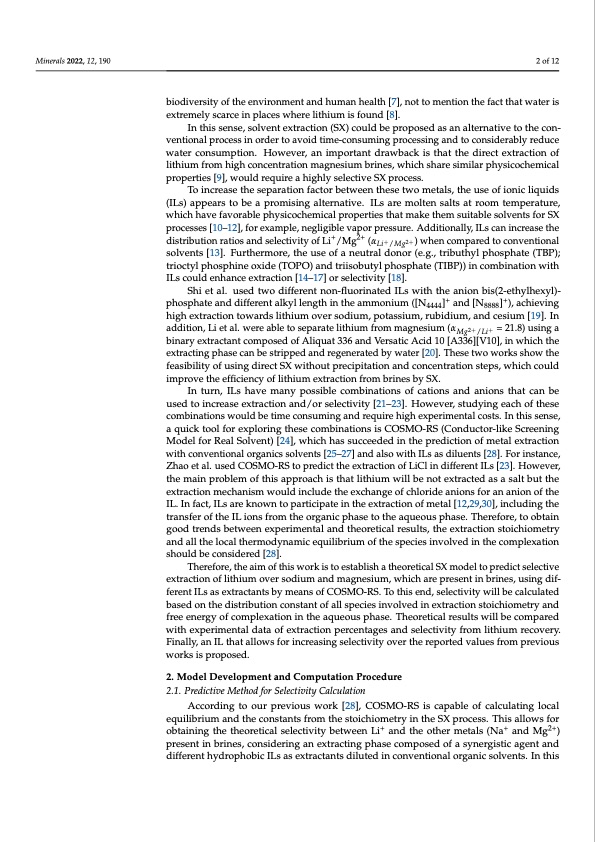
PDF Publication Title:
Text from PDF Page: 002
Minerals 2022, 12, 190 2 of 12 biodiversity of the environment and human health [7], not to mention the fact that water is extremely scarce in places where lithium is found [8]. In this sense, solvent extraction (SX) could be proposed as an alternative to the con- ventional process in order to avoid time-consuming processing and to considerably reduce water consumption. However, an important drawback is that the direct extraction of lithium from high concentration magnesium brines, which share similar physicochemical properties [9], would require a highly selective SX process. To increase the separation factor between these two metals, the use of ionic liquids (ILs) appears to be a promising alternative. ILs are molten salts at room temperature, which have favorable physicochemical properties that make them suitable solvents for SX processes [10–12], for example, negligible vapor pressure. Additionally, ILs can increase the distribution ratios and selectivity of Li+/Mg2+ (αLi+/Mg2+ ) when compared to conventional solvents [13]. Furthermore, the use of a neutral donor (e.g., tributhyl phosphate (TBP); trioctyl phosphine oxide (TOPO) and triisobutyl phosphate (TIBP)) in combination with ILs could enhance extraction [14–17] or selectivity [18]. Shi et al. used two different non-fluorinated ILs with the anion bis(2-ethylhexyl)- phosphate and different alkyl length in the ammonium ([N4444]+ and [N8888]+), achieving high extraction towards lithium over sodium, potassium, rubidium, and cesium [19]. In addition,Lietal.wereabletoseparatelithiumfrommagnesium(αMg2+/Li+ =21.8)usinga binary extractant composed of Aliquat 336 and Versatic Acid 10 [A336][V10], in which the extracting phase can be stripped and regenerated by water [20]. These two works show the feasibility of using direct SX without precipitation and concentration steps, which could improve the efficiency of lithium extraction from brines by SX. In turn, ILs have many possible combinations of cations and anions that can be used to increase extraction and/or selectivity [21–23]. However, studying each of these combinations would be time consuming and require high experimental costs. In this sense, a quick tool for exploring these combinations is COSMO-RS (Conductor-like Screening Model for Real Solvent) [24], which has succeeded in the prediction of metal extraction with conventional organics solvents [25–27] and also with ILs as diluents [28]. For instance, Zhao et al. used COSMO-RS to predict the extraction of LiCl in different ILs [23]. However, the main problem of this approach is that lithium will be not extracted as a salt but the extraction mechanism would include the exchange of chloride anions for an anion of the IL. In fact, ILs are known to participate in the extraction of metal [12,29,30], including the transfer of the IL ions from the organic phase to the aqueous phase. Therefore, to obtain good trends between experimental and theoretical results, the extraction stoichiometry and all the local thermodynamic equilibrium of the species involved in the complexation should be considered [28]. Therefore, the aim of this work is to establish a theoretical SX model to predict selective extraction of lithium over sodium and magnesium, which are present in brines, using dif- ferent ILs as extractants by means of COSMO-RS. To this end, selectivity will be calculated based on the distribution constant of all species involved in extraction stoichiometry and free energy of complexation in the aqueous phase. Theoretical results will be compared with experimental data of extraction percentages and selectivity from lithium recovery. Finally, an IL that allows for increasing selectivity over the reported values from previous works is proposed. 2. Model Development and Computation Procedure 2.1. Predictive Method for Selectivity Calculation According to our previous work [28], COSMO-RS is capable of calculating local equilibrium and the constants from the stoichiometry in the SX process. This allows for obtaining the theoretical selectivity between Li+ and the other metals (Na+ and Mg2+) present in brines, considering an extracting phase composed of a synergistic agent and different hydrophobic ILs as extractants diluted in conventional organic solvents. In thisPDF Image | Ionic Liquids for the Selective Solvent Extraction of Lithium

PDF Search Title:
Ionic Liquids for the Selective Solvent Extraction of LithiumOriginal File Name Searched:
minerals-12-00190-v3.pdfDIY PDF Search: Google It | Yahoo | Bing
Product and Development Focus for Infinity Turbine
ORC Waste Heat Turbine and ORC System Build Plans: All turbine plans are $10,000 each. This allows you to build a system and then consider licensing for production after you have completed and tested a unit.Redox Flow Battery Technology: With the advent of the new USA tax credits for producing and selling batteries ($35/kW) we are focussing on a simple flow battery using shipping containers as the modular electrolyte storage units with tax credits up to $140,000 per system. Our main focus is on the salt battery. This battery can be used for both thermal and electrical storage applications. We call it the Cogeneration Battery or Cogen Battery. One project is converting salt (brine) based water conditioners to simultaneously produce power. In addition, there are many opportunities to extract Lithium from brine (salt lakes, groundwater, and producer water).Salt water or brine are huge sources for lithium. Most of the worlds lithium is acquired from a brine source. It's even in seawater in a low concentration. Brine is also a byproduct of huge powerplants, which can now use that as an electrolyte and a huge flow battery (which allows storage at the source).We welcome any business and equipment inquiries, as well as licensing our turbines for manufacturing.| CONTACT TEL: 608-238-6001 Email: greg@infinityturbine.com | RSS | AMP |